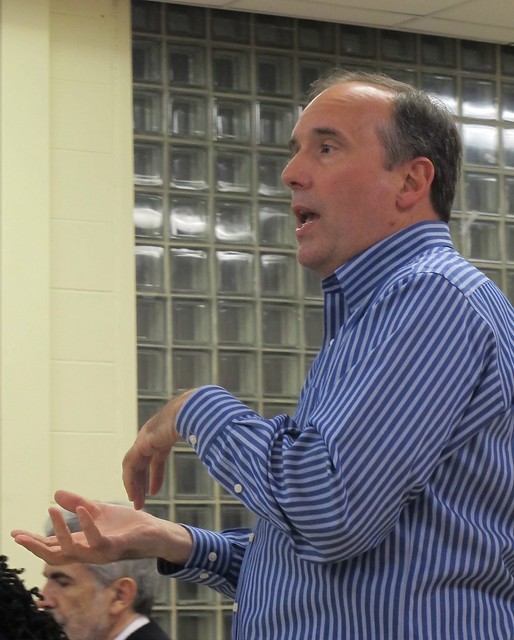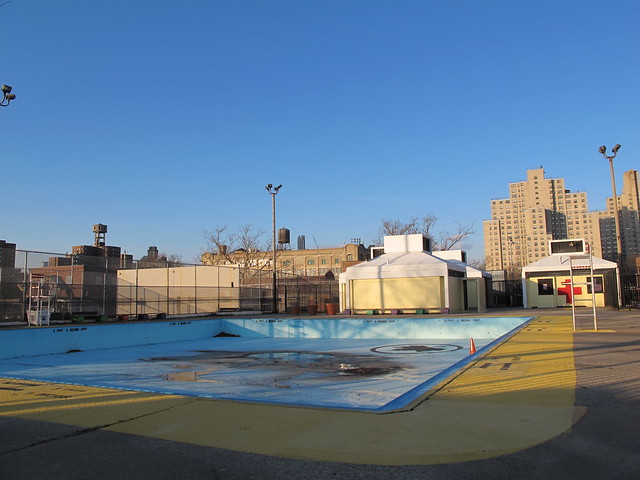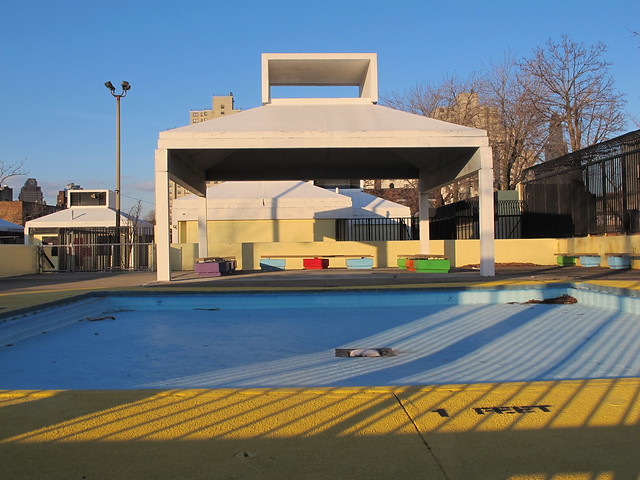Doug Sarno, facilitator for EPA Gowanus Canal Superfund CAG
Christos Tsiamis, EPA Remedial Project Manager for the Gowanus Canal
Councilman Stephen Levin, 33rd Council District
Christos Tsiamis and Stephen Levin
Councilman Brad Lander, 39th Council District
This past Tuesday evening, the Environmental Protection Agency's Gowanus Superfund Community Advisory Group (CAG) hosted Councilman Stephen Levin and Councilman Brad Lander for a conversation about the City's role now that the EPA’s Record of Decision (ROD) for the canal cleanup has been signed.
The EPA is swiftly moving forward with the design for the environmental remediation and has requested a decision from the City by July 2014 on the location of two mandated retention tanks for combined sewer overflow.
The CAG's discussion with both Council members centered on the impact of development on the
banks of the canal, size and location of the retention tanks, hydrology of the area and the relationship between the EPA and the City.
The CAG's discussion with both Council members centered on the impact of development on the
banks of the canal, size and location of the retention tanks, hydrology of the area and the relationship between the EPA and the City.
Christos Tsiamis, Project Manager for the Gowanus Canal, Brian Carr, Legal Council, and Natalie Loney, Community Involvement Coordinator for EPA Region 2, were also in attendance.
Since Levin and Lander attended Tuesday's general CAG meeting at different times, the conversation with each councilman focused on slightly different topics.
Conversation with Councilman Steve Levin
Th discussion between the CAG and Council member Levin, whose district covers the head of the canal, focused mostly on the location of the EPA mandated retention tanks.
"As many of you may know, I was supportive of the Superfund designation to begin with and I am very appreciative of EPA's stellar work and their collaborative effort, their willingness to work with the CAG and the greater community on coming up with a plan that is thorough and looks to address all the outstanding issues once and for all," Levin told members of the CAG.
"I want to make sure that all aspects of contributing pollution to the Gowanus Canal are addressed thoroughly through this process, that the City is a partner and doesn't skirt its responsibility, and that all Potentially Responsible Partners [PRP] meet their liability."
Levin expressed his concern about the possibility of placing one of the retention basins underneath the "Double D" pool at Thomas Greene Park. The pool is an important resource for his constituents, he noted. "I would like to see other sites considered because I want to make sure that the pool stays a pool and that the park is not disrupted."
In the Record of Decision, the EPA has proposed this particular location for a retention tank because:
-the pool sits on a former Manufacturing Gas Site and the land underneath it may need to be remediated by National Grid, the named PRP.
-the largest outflow, which is responsible for much of the raw sewage into the canal, is at the head of the canal at Douglass Street, near the park.
-The park is one of the only open pieces of land in this densely populated area.
-the land is already owned by New York City.
-the pool sits on a former Manufacturing Gas Site and the land underneath it may need to be remediated by National Grid, the named PRP.
-the largest outflow, which is responsible for much of the raw sewage into the canal, is at the head of the canal at Douglass Street, near the park.
-The park is one of the only open pieces of land in this densely populated area.
-the land is already owned by New York City.
Remediation, Levin conceded, should dictate the final decision: "I want to make sure that all pollution is addressed. That includes all CSOs. If that means retention tanks are needed, I defer to the wise judgement of the EPA."
If one of the retention basins must be placed at this location, Levin wants to make sure the community has a locked in, up front agreement that the public amenity will be replaced or repaid in kind. "I don't want to be in the position that six years from now, retention tanks are in, the pool is dug up, and no one is going to pay for a new one. I am not saying who should pay for it, National Grid or the City. I am just saying, someone needs to pay for it."
Christos Tsiamis of Region 2 clarified that the City is responsible for the retention tanks. "That's in the Record of Decision. We have given the City the flexibility to suggest alternate locations. We have had a walk-through with the City to suggest other sites that we had in mind. No new sites were brought up to us by the City. We will have another meeting with them in a week to two. So the process continues."
As far as the pollution underneath the Double D Pool, Tsiamis explained: "90 % of the contamination is on the western half of the park, the part where the pool is. The feasibility study by the State has not come out yet. [When it does] we will comment on it because it is tied up with our cleanup. The fact is, work will be done, remediation will take place on that site."
Asked how the community can make sure that the de Blasio administration will work more cooperatively with the EPA than the previous administration, Levin suggested that the Superfund process is now well on its way. "I would argue in general that it is better to go along with the process than go kicking and screaming. Besides being a better principle, it's also more cost effective than fighting everything. We want to get this done in a timely fashion, in a way in which we can feel confident that we are leaving a clean Gowanus Canal for future generations of New Yorkers. The best way of doing that is through co-operation instead of fighting it."
And with a smile, he added, "the Feds always win."
Conversation with Brad Lander
Councilman Brad Lander's, whose 39th Council district includes the largest swath of Gowanus, told the CAG that the recent appointment of Emily Lloyd as NYC Department Of Environmental Protection's Commissioner will hopefully mark the beginning of a real collaboration between the City and the EPA. "I think the world of Emily Lloyd. She cares deeply about the environment, is really thoughtful about working with different sets of people, and she knows a lot about how government and communities work. I think that bodes well for having a conversation with her about what the next steps will be," he said.
Lander acknowledged that the work that has been done by the EPA so far has made it possible to have a conversation about the future of the Gowanus Canal area in the first place. He recently co-sponored 'Bridging Gowanus', a collaborative plan that represents the goals that people have for the community.
"We started from the point that we wanted to develop as much consensus as we can. Step one was to create a set of common values. From the feed back, there is very substantial, even overwhelming consensus around that set of values. Step two was to break down into small working groups and start to develop some set of ideas that advance those values. The third step is probably going to be the most challenging. That's the one where we talk about ideas around which there is less consensus, and where people think about the tradeoffs between density and development, where, and if and how it should take place, how big it should be and what it should be, the goals and value that people set, the risks of harm, and the risks of inaction."
According to Lander, the final 'Bridging Gowanus' document will be used to have a dialog with NY City Planning "about where we go in the future. One of the reason why I believe it is in our shared interest to develop consensus around land use is to minimize the individual actions that take place."
Members of the CAG asked that there be more cross-fertilization between members of the CAG and those involved with"Bridging Gowanus. Lander promised to encourage more dialog.
Members of the CAG asked that there be more cross-fertilization between members of the CAG and those involved with"Bridging Gowanus. Lander promised to encourage more dialog.
Speaking about future development along the Gowanus Canal, Brian Carr of EPA reminded everyone that the Agency specifically wrote into its Record Of Decision that new buildings on the uplands need to capture a certain amount of sewage related contamination from going into the canal, and that we need to make sure that the remedy is effective over time.
"We expect that the City's regulation on how new construction takes place, for which we have a certain amount of discretion for approval, will become much more mandatory. They need to do that to make sure that they don't outsize whatever tanks get built. There is no point in building a tank and then exceeding its capacity a month later. That is built into the remedy and we would consider this an institutional control", he explained.
Carr concluded: "For better or worse, what happens along the canal comes through us to some extent."










.JPG)

3 comments:
Blah, blah, blah. Just get it done.
the next meeting will be held to discuss scheduling an upcoming meeting...in the meantime did anybody bother to ask if EPA has entered into an agreement yet with national grid to do the dredging?
On the "Bridging Gowanus" thing, to be a collaborative plan means that all parties would be participating on equal footing. But this is not the case with this process.
The Lander-controlled Pratt group is the only entity that gets to pick and chose what they state as the consensus community goals. There is not data of any sorts backing the statements they have claimed to be held by the community.
Would love to see some kind of polling on the said community consensus list.
Post a Comment